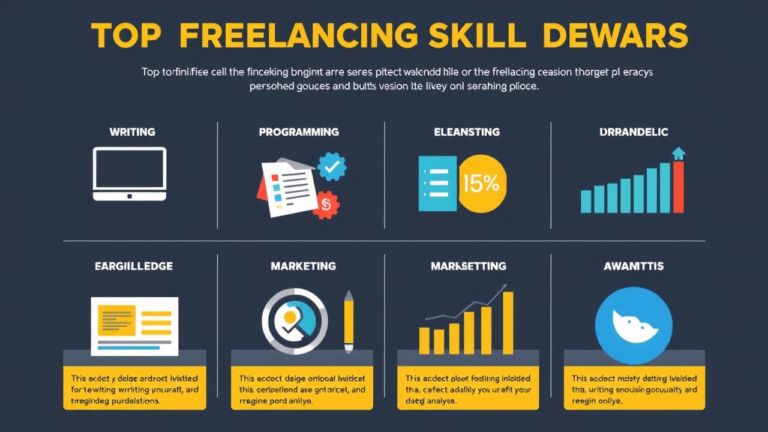The Ultimate Guide to Building a Successful Freelance Career
Introduction
In recent years, the freelance economy has experienced exponential growth. With the advent of digital platforms, remote work opportunities, and the increasing demand for specialized skills, more and more professionals are choosing to leave traditional 9-to-5 jobs in favor of freelancing. The allure of flexibility, autonomy, and the potential for higher earnings has made freelancing an attractive career option for many. However, building a successful freelance career is not without its challenges. It requires a combination of skills, strategies, and mindset to thrive in this competitive landscape.
This comprehensive guide will walk you through the essential steps to building a successful freelance career. From identifying your niche and setting up your business to marketing your services and managing your finances, we’ll cover everything you need to know to become a top-performing freelancer.
Understanding the Freelance Landscape
1.1 What is Freelancing?
Freelancing refers to a type of self-employment where individuals offer their services to clients on a project or contract basis, rather than being employed by a single company. Freelancers are often referred to as independent contractors, and they can work in a wide range of industries, including writing, design, programming, marketing, consulting, and more.
1.2 The Rise of the Freelance Economy
The freelance economy has grown significantly over the past decade, driven by several factors:
- Technological Advancements: The internet and digital tools have made it easier for freelancers to connect with clients, collaborate remotely, and deliver work online.
- Changing Work Preferences: Many professionals are seeking greater flexibility and work-life balance, which freelancing can provide.
- Economic Shifts: Companies are increasingly looking to reduce costs by hiring freelancers for specific projects rather than maintaining a full-time workforce.
- Globalization: Freelancers can now work with clients from all over the world, expanding their opportunities beyond local markets.
1.3 Pros and Cons of Freelancing
Before diving into freelancing, it’s important to weigh the pros and cons to determine if it’s the right career path for you.
Pros:
- Flexibility: Freelancers have the freedom to set their own schedules and choose the projects they want to work on.
- Autonomy: You have full control over your work, from the clients you work with to the rates you charge.
- Unlimited Earning Potential: Unlike traditional jobs with fixed salaries, freelancers can increase their income by taking on more projects or raising their rates.
- Diverse Work Experience: Freelancers often work on a variety of projects, which can lead to a more diverse and enriching work experience.
Cons:
- Income Variability: Freelancers may experience fluctuations in income, especially when starting out or during slow periods.
- Lack of Benefits: Freelancers typically don’t receive benefits like health insurance, retirement plans, or paid time off.
- Self-Employment Taxes: Freelancers are responsible for paying their own taxes, which can be more complex than traditional employment.
- Isolation: Working independently can sometimes lead to feelings of isolation, especially if you’re used to a collaborative office environment.
Identifying Your Niche
2.1 Why Choosing a Niche is Important
One of the most critical steps in building a successful freelance career is identifying your niche. A niche is a specialized area of expertise that sets you apart from the competition. By focusing on a specific niche, you can position yourself as an expert, attract the right clients, and command higher rates.
2.2 How to Choose Your Niche
When choosing your niche, consider the following factors:
- Skills and Expertise: What are you good at? What skills do you have that are in demand?
- Passion and Interest: What do you enjoy doing? Freelancing is more sustainable when you’re passionate about your work.
- Market Demand: Is there a demand for your skills? Research the market to identify areas with high demand and low competition.
- Profitability: Can you make a living in this niche? Consider the earning potential and whether it aligns with your financial goals.
2.3 Examples of Freelance Niches
Here are some popular freelance niches to consider:
- Writing and Content Creation: Blogging, copywriting, technical writing, ghostwriting, and content strategy.
- Design and Creative Services: Graphic design, web design, UX/UI design, illustration, and video editing.
- Programming and Development: Web development, mobile app development, software engineering, and game development.
- Marketing and Advertising: Social media management, SEO, PPC advertising, email marketing, and influencer marketing.
- Consulting and Coaching: Business consulting, career coaching, life coaching, and financial consulting.
- Administrative Support: Virtual assistance, data entry, customer service, and project management.
2.4 Testing Your Niche
Once you’ve identified a potential niche, it’s important to test it before fully committing. Start by taking on a few projects in your chosen niche to see if it’s a good fit. Pay attention to how much you enjoy the work, the demand for your services, and the profitability. If the niche doesn’t meet your expectations, don’t be afraid to pivot and explore other options.
Setting Up Your Freelance Business
3.1 Legal Considerations
Before you start freelancing, it’s important to address the legal aspects of running a business. This includes:
- Business Structure: Decide whether you want to operate as a sole proprietor, LLC, or another business structure. Each has its own legal and tax implications.
- Business Name: Choose a name for your freelance business that reflects your brand and is easy to remember.
- Licenses and Permits: Depending on your location and industry, you may need to obtain specific licenses or permits to operate legally.
- Contracts: Always use contracts to outline the terms of your work with clients. This helps protect both parties and ensures clear communication.
3.2 Setting Up Your Workspace
Creating a productive workspace is essential for freelancers. Consider the following tips:
- Dedicated Space: Set up a dedicated workspace where you can focus on your work without distractions.
- Ergonomics: Invest in ergonomic furniture and equipment to ensure comfort and prevent strain.
- Technology: Make sure you have the necessary technology, such as a reliable computer, high-speed internet, and any specialized software or tools required for your niche.
- Organization: Keep your workspace organized to improve efficiency and reduce stress.
3.3 Setting Your Rates
Determining your rates is one of the most challenging aspects of freelancing. Here are some factors to consider when setting your rates:
- Experience and Expertise: More experienced freelancers can typically charge higher rates.
- Market Rates: Research what other freelancers in your niche are charging to get an idea of the going rate.
- Project Complexity: More complex projects may warrant higher rates.
- Client Budget: Consider the budget of your target clients when setting your rates.
- Value-Based Pricing: Instead of charging by the hour, consider pricing based on the value you provide to the client.
3.4 Creating a Portfolio
A strong portfolio is essential for showcasing your skills and attracting clients. Here’s how to create an effective portfolio:
- Select Your Best Work: Choose a selection of your best work that demonstrates your skills and expertise.
- Showcase Diversity: Include a variety of projects to show your versatility.
- Provide Context: For each project, provide a brief description of the client’s goals, your approach, and the results achieved.
- Make it Accessible: Create an online portfolio that’s easy to navigate and accessible to potential clients.
3.5 Building Your Brand
Your personal brand is what sets you apart from other freelancers. Here’s how to build a strong brand:
- Define Your Unique Value Proposition: What makes you different from other freelancers in your niche? Clearly articulate your unique value proposition.
- Create a Professional Online Presence: Develop a professional website and social media profiles that reflect your brand.
- Consistency: Ensure that your branding is consistent across all platforms, including your website, social media, and portfolio.
- Networking: Build relationships with other professionals in your industry to increase your visibility and credibility.
Finding and Attracting Clients
4.1 Where to Find Freelance Clients
Finding clients is one of the biggest challenges freelancers face. Here are some strategies for finding freelance clients:
- Freelance Platforms: Websites like Upwork, Fiverr, Freelancer, and Toptal are popular platforms for finding freelance work.
- Networking: Attend industry events, join professional organizations, and connect with other freelancers to expand your network.
- Social Media: Use social media platforms like LinkedIn, Twitter, and Instagram to promote your services and connect with potential clients.
- Cold Pitching: Reach out to potential clients directly via email or LinkedIn with a personalized pitch.
- Referrals: Ask satisfied clients for referrals and encourage them to recommend your services to others.
4.2 Crafting a Winning Proposal
When applying for freelance projects, your proposal is your first impression. Here’s how to craft a winning proposal:
- Personalization: Tailor your proposal to the specific client and project. Show that you’ve done your research and understand their needs.
- Highlight Your Expertise: Clearly demonstrate your skills and experience, and explain why you’re the best fit for the project.
- Provide a Clear Plan: Outline your approach to the project, including the steps you’ll take and the timeline for completion.
- Include a Call to Action: End your proposal with a clear call to action, such as scheduling a call or meeting to discuss the project further.
4.3 Building Long-Term Client Relationships
Building long-term relationships with clients is key to a sustainable freelance career. Here’s how to foster strong client relationships:
- Communication: Maintain open and clear communication with your clients throughout the project.
- Reliability: Deliver high-quality work on time and meet your commitments.
- Professionalism: Be professional in all your interactions, from emails to meetings.
- Going the Extra Mile: Exceed client expectations by delivering more than what was asked for.
- Follow-Up: After completing a project, follow up with the client to ensure their satisfaction and explore opportunities for future work.
4.4 Handling Rejection
Rejection is a natural part of freelancing. Here’s how to handle it:
- Don’t Take it Personally: Rejection is often not a reflection of your skills or worth, but rather a mismatch between the client’s needs and your offering.
- Learn from Feedback: If a client provides feedback, use it as an opportunity to improve.
- Stay Persistent: Keep applying for projects and pitching to clients. Persistence is key to success in freelancing.
- Maintain a Positive Mindset: Focus on the clients who appreciate your work and the projects you enjoy.
Managing Your Freelance Business
5.1 Time Management
Effective time management is crucial for freelancers. Here are some tips for managing your time:
- Set a Schedule: Establish a daily or weekly schedule that includes dedicated work hours.
- Prioritize Tasks: Focus on high-priority tasks that have the greatest impact on your business.
- Use Time-Tracking Tools: Use tools like Toggl or Harvest to track your time and ensure you’re staying on track.
- Avoid Multitasking: Focus on one task at a time to improve productivity and quality.
- Take Breaks: Schedule regular breaks to avoid burnout and maintain focus.
5.2 Financial Management
Managing your finances is a critical aspect of running a successful freelance business. Here’s how to stay on top of your finances:
- Separate Business and Personal Finances: Open a separate bank account and credit card for your freelance business.
- Track Income and Expenses: Use accounting software like QuickBooks or FreshBooks to track your income and expenses.
- Set Aside Taxes: As a freelancer, you’re responsible for paying your own taxes. Set aside a portion of your income for taxes to avoid surprises at tax time.
- Create a Budget: Develop a budget that includes your business expenses, personal expenses, and savings goals.
- Invoice Promptly: Send invoices to clients promptly and follow up on overdue payments.
5.3 Managing Client Expectations
Managing client expectations is essential for maintaining positive relationships and avoiding misunderstandings. Here’s how to do it:
- Set Clear Expectations: Clearly outline the scope of work, timeline, and deliverables in your contract or agreement.
- Communicate Regularly: Keep clients informed of your progress and any potential delays or issues.
- Be Transparent: If you encounter challenges, be honest with your client and propose solutions.
- Underpromise and Overdeliver: Set realistic expectations and strive to exceed them.
5.4 Dealing with Difficult Clients
Not all clients are easy to work with. Here’s how to handle difficult clients:
- Stay Professional: Maintain a professional demeanor, even if the client is being difficult.
- Set Boundaries: Clearly define your boundaries and stick to them.
- Communicate Clearly: Address issues directly and communicate your concerns in a respectful manner.
- Know When to Walk Away: If a client is consistently difficult or abusive, it may be best to end the relationship.
5.5 Scaling Your Freelance Business
As your freelance career grows, you may want to scale your business. Here are some strategies for scaling:
- Outsource: Delegate tasks to other freelancers or virtual assistants to free up your time for higher-value work.
- Raise Your Rates: As you gain experience and expertise, consider raising your rates to reflect your increased value.
- Expand Your Services: Offer additional services that complement your existing offerings to attract more clients.
- Build a Team: If your workload becomes too much to handle alone, consider hiring employees or forming a team of freelancers.
Marketing Your Freelance Services
6.1 Building an Online Presence
An online presence is essential for attracting clients and building your brand. Here’s how to build a strong online presence:
- Create a Professional Website: Your website is your online storefront. Make sure it’s professional, easy to navigate, and showcases your portfolio and services.
- Optimize for SEO: Use search engine optimization (SEO) techniques to improve your website’s visibility in search engine results.
- Leverage Social Media: Use social media platforms to promote your services, share your work, and engage with potential clients.
- Start a Blog: Blogging can help establish you as an expert in your niche and drive traffic to your website.
6.2 Content Marketing
Content marketing is a powerful way to attract clients and build your reputation. Here’s how to use content marketing:
- Create Valuable Content: Produce high-quality content that provides value to your target audience, such as blog posts, videos, or infographics.
- Share Your Expertise: Use your content to showcase your knowledge and expertise in your niche.
- Promote Your Content: Share your content on social media, in email newsletters, and on relevant online communities.
- Engage with Your Audience: Respond to comments and questions on your content to build relationships with your audience.
6.3 Email Marketing
Email marketing is an effective way to stay in touch with clients and prospects. Here’s how to use email marketing:
- Build an Email List: Collect email addresses from your website visitors, social media followers, and clients.
- Send Regular Newsletters: Send regular newsletters with updates, tips, and offers to keep your audience engaged.
- Personalize Your Emails: Personalize your emails to make them more relevant and engaging.
- Include a Call to Action: Encourage recipients to take action, such as visiting your website or contacting you for a consultation.
6.4 Networking and Collaboration
Networking and collaboration can help you expand your reach and attract new clients. Here’s how to network effectively:
- Attend Industry Events: Attend conferences, meetups, and other industry events to connect with potential clients and collaborators.
- Join Online Communities: Participate in online forums, groups, and communities related to your niche.
- Collaborate with Other Freelancers: Partner with other freelancers on projects or cross-promote each other’s services.
- Ask for Referrals: Ask satisfied clients and colleagues for referrals to new clients.
6.5 Paid Advertising
Paid advertising can help you reach a larger audience and attract more clients. Here’s how to use paid advertising:
- Google Ads: Use Google Ads to target potential clients who are searching for your services.
- Social Media Ads: Run ads on social media platforms like Facebook, Instagram, and LinkedIn to promote your services.
- Retargeting: Use retargeting ads to reach people who have visited your website but didn’t convert.
- Monitor and Optimize: Track the performance of your ads and optimize them for better results.
Staying Motivated and Overcoming Challenges
7.1 Staying Motivated
Freelancing can be challenging, and it’s important to stay motivated. Here are some tips for staying motivated:
- Set Goals: Set clear, achievable goals for your freelance career and track your progress.
- Celebrate Successes: Celebrate your achievements, no matter how small, to stay motivated.
- Stay Inspired: Surround yourself with inspiration, whether it’s through books, podcasts, or networking with other freelancers.
- Take Care of Yourself: Prioritize self-care, including exercise, healthy eating, and getting enough sleep.
7.2 Overcoming Common Freelance Challenges
Freelancers face a variety of challenges, from finding clients to managing finances. Here’s how to overcome some common challenges:
- Feast or Famine: To avoid periods of low income, diversify your client base and continuously market your services.
- Isolation: Combat isolation by joining freelance communities, co-working spaces, or attending networking events.
- Burnout: Prevent burnout by setting boundaries, taking breaks, and maintaining a healthy work-life balance.
- Imposter Syndrome: Overcome imposter syndrome by focusing on your achievements and seeking support from peers.
7.3 Continuous Learning and Improvement
The freelance landscape is constantly evolving, and it’s important to stay ahead of the curve. Here’s how to continuously learn and improve:
- Stay Updated: Keep up with industry trends, new tools, and best practices in your niche.
- Invest in Education: Take courses, attend workshops, and read books to enhance your skills and knowledge.
- Seek Feedback: Regularly seek feedback from clients and peers to identify areas for improvement.
- Experiment and Innovate: Don’t be afraid to try new approaches and experiment with different strategies.
Conclusion
Building a successful freelance career is a journey that requires dedication, resilience, and continuous learning. By identifying your niche, setting up your business, finding and attracting clients, and effectively managing your time and finances, you can create a thriving freelance career that offers flexibility, autonomy, and financial rewards.
Remember, freelancing is not just about working for yourself—it’s about building a business that aligns with your passions and goals. With the right mindset and strategies, you can overcome the challenges of freelancing and achieve long-term success.
Whether you’re just starting out or looking to take your freelance career to the next level, this guide provides the tools and insights you need to succeed. So, take the leap, embrace the freelance lifestyle, and start building the career of your dreams today.





